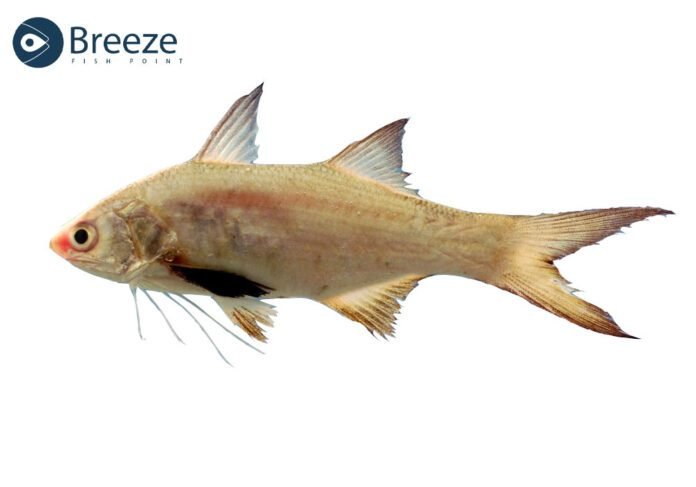If you’re a seafood lover or an angler curious about what’s swimming in tropical waters, you’ve likely heard of threadfin fish—those shimmering, silvery beauties that are as fascinating as they are delicious. Among them, the threadfin bream, often called chakori in some regions, stands out for its delicate flavor and versatility in the kitchen. Whether you’re casting a line or browsing the market, threadfin fish have a unique charm that’s hard to ignore. In this blog, we’ll dive deep into the world of threadfins, exploring their characteristics, species, and why they’re a favorite for both chefs and fishermen.
Let’s unravel the magic of these finned wonders and answer all your burning questions!
Table of Contents
What Makes Threadfin Fish So Special?
Threadfin fish, often called thread fish or threadfins, are a family of marine marvels that swim in tropical and subtropical waters worldwide. Belonging to the Polynemidae family, these fish are known for their sleek, silvery bodies and unique pectoral fins that split into thread-like rays—hence the name. These threads aren’t just for show; they act like sensory superpowers, helping threadfins detect prey in murky waters. Whether you’re a chef dreaming up a gourmet dish or an angler chasing a prized catch, threadfins offer something for everyone.
- Global Presence: Found from the Persian Gulf to Australia, threadfins thrive in warm coastal waters, estuaries, and even rivers during certain seasons.
- Commercial Value: Their tendency to form large schools makes them a reliable catch for fisheries, ensuring they’re a staple in markets.
- Culinary Darling: With tender, sweet flesh, threadfins are a hit in dishes like steamed fish or crispy fillets, especially in places like Hong Kong and Singapore.
How Do You Identify a Threadfin Fish?
Spotting a threadfin fish in the market or on your line is easier when you know what to look for. Their key characteristics set them apart from other fish, making identification a breeze even for beginners.
- Thread-Like Fins: The hallmark of threadfins is their pectoral fins, which split into 3–7 long, thread-like rays used for sensing prey. These are especially prominent in juveniles.
- Silvery Shine: Their bodies are elongated, fusiform (tapered at both ends), and covered in silvery-grey scales that catch the light beautifully.
- Forked Tail: A deeply forked tail fin signals their speed and agility, perfect for darting through coastal waters.
- Dorsal Fins: They have two distinct dorsal fins—one spiny, one soft—widely separated, giving them a unique silhouette.
- Tail Shape Tip: Wild threadfins have leaner, longer tails compared to their fatter, farmed counterparts. Look at the tail to tell them apart
Pro Tip: If you’re at a wet market, check the fin color. For example, farmed fourfinger threadfins might have yellow fins, while wild ones often sport black.
What Are the Scientific Names of Threadfin Fish?
Common Name | Scientific Name | Region |
Fourfinger Threadfin | Eleutheronema tetradactylum | Indo-Pacific, Persian Gulf to Australia |
East Asian Fourfinger Threadfin | Eleutheronema rhadinum | East Asia (China, Japan, Vietnam) |
Threefinger Threadfin | Eleutheronema tridactylum | Southeast Asia |
Indian Threadfin | Leptomelanosoma indicum | South-east Asia, Papua New Guinea |
Giant African Threadfin | Polydactylus quadrifilis | African coasts |
Dwarf Threadfin | Parapolynemus verekeri | Tropical waters |
What Is Threadfin Bream (Chakori)?

The threadfin bream, locally known as chakori in some regions, isn’t a true threadfin from the Polynemidae family but is often confused due to its similar appearance and name. Belonging to the Nemipteridae family, threadfin breams are prized for their pinkish hue and mild, sweet flavor, making them a favorite in Asian cuisine.
- Appearance: They have a slender body with a rosy-pink color and long, thread-like dorsal fin rays, which spark the name confusion.
- Habitat: Found in the Indo-Pacific, they prefer sandy or muddy bottoms in coastal waters.
- Culinary Use: Perfect for curries, grilling, or frying, threadfin bream is a versatile fish that’s easy to cook and loved for its flaky texture.
Fun Fact: In India, chakori is a popular choice for coastal dishes, often cooked with spices to enhance its natural sweetness.
What Is Threadfin Shad?

Threadfin shad (Dorosoma petenense) isn’t a true threadfin either but belongs to the Clupeidae family (herrings). It’s often mistaken for threadfins due to a single thread-like ray extending from its dorsal fin. Here’s what you need to know:
- Size and Habitat: These small fish, rarely exceeding 20 cm, thrive in warm, freshwater lakes, rivers, and reservoirs, especially in North America.
- Role in Ecosystem: Threadfin shad are a vital forage fish, serving as prey for larger species like bass and catfish.
- Fishing Appeal: Anglers use them as bait due to their abundance and attractiveness to predatory fish.
Quick Tip: If you’re fishing in freshwater and spot a small, silvery fish with a single thread-like fin ray, it’s likely a threadfin shad, not a Polynemidae threadfin.
What About Threadfin Rainbowfish?

The threadfin rainbowfish (Iriatherina werneri) is another fish that borrows the “threadfin” name, but it’s a freshwater species from the Melanotaeniidae family. Native to Australia and New Guinea, it’s a darling of the aquarium trade.
- Stunning Looks: Males boast long, flowing fin extensions, especially on the dorsal and anal fins, which shimmer with iridescent colors.
- Aquarium Favorite: Their small size (up to 5 cm) and peaceful nature make them ideal for community tanks.
- Care Tips: Keep them in slightly acidic water with plenty of plants and a varied diet of flakes and live food.
Magic Point: Threadfin rainbowfish are perfect for aquarists looking to add a splash of color without needing a massive tank.
Which Other Threadfin Species Should You Know?
Beyond the fourfinger threadfin (Eleutheronema tetradactylum) and East Asian fourfinger threadfin (Eleutheronema rhadinum), the Polynemidae family is packed with fascinating species. Here are a few more to pique your interest:
- Giant African Threadfin (Polydactylus quadrifilis): Grows up to 2 meters and is a prized gamefish in African waters.
- Indian Threadfin (Leptomelanosoma indicum): Known as Balai Ngor in Singapore, it’s a favorite for its soft, sweet meat, especially for kids.
- Australian Threadfin (Polydactylus multiradiatus): A smaller species with seven pectoral filaments, often found in Australia’s coastal waters.
Each species has its own quirks, from fin color to habitat preferences, making the threadfin family a diverse bunch.
How Can You Catch Threadfin Fish?
Threadfin fishing is a thrill for anglers, especially for species like the fourfinger threadfin, known as ea ma yau (Horse Friend) in Cantonese due to its abundance in certain seasons. Here’s how to hook one:
- Best Locations: Target shallow, muddy coastal waters, estuaries, or river mouths, especially in the Indo-Pacific. Winter is prime time in places like Taiwan and Hong Kong.
- Tackle and Bait: Use light tackle with live prawns or small fish like mullets, as threadfins are carnivorous and love crustaceans.
- Techniques: Cast near structures or in turbid waters where threadfins hunt. Trolling or bottom fishing works well for larger specimens.
- Seasonal Tip: In Hong Kong, the “horseracing season” (winter) is ideal for catching bigger threadfins, some reaching 10–12 kg.
Pro Tip: Check local regulations, as some areas have size or bag limits to protect threadfin populations.
Are Mala Fish and Threadfin Fish the Same?
No, mala fish and threadfin fish are not the same, though the confusion is understandable. Mala fish is a colloquial term often used in South Asia for various white-fleshed fish, sometimes including threadfin bream or even fourfinger threadfin (Eleutheronema tetradactylum). However, it’s not a specific species and can refer to other fish like pomfret or snapper, depending on the region.
- Key Difference: Threadfins (Polynemidae) have those signature thread-like pectoral rays, while mala fish is a broader, less precise term.
- Culinary Note: Both are prized for their mild flavor, but threadfins are often preferred for steaming due to their tender texture.
Clearing the Confusion: Always ask your fishmonger for the scientific name or check the fins to ensure you’re getting a true threadfin.
Why Is Threadfin Fish a Culinary Gem?
Threadfin fish, sometimes called fish threadfin or thread fin, shine in the kitchen thanks to their versatility and health benefits. Here’s why they’re a chef’s dream:
- Tender Texture: Their soft, flaky meat is easy to chew, making them ideal for kids and the elderly.
- Mild Flavor: The sweet, delicate taste pairs well with bold sauces like Shaoxing wine or subtle steaming with ginger.
- Health Benefits: Low in mercury and high in omega-3s, threadfins are a safe, nutritious choice for all ages.
- Popular Dishes: Try steamed fourfinger threadfin with chicken oil (Hong Kong style) or crispy Indian threadfin with tofu skin at Michelin-starred restaurants.
Magic Cooking Tip: For the freshest flavor, opt for wild-caught threadfins with a golden hue on their skin, and steam them to lock in their natural sweetness.
FAQs
Q1: Are threadfin fish and treadfin the same?
Q2: Can threadfin fish be farmed?
Q3: Are threadfins good for aquariums?
Q4: Why are threadfins called ea ma yau?
Q5: How do I know if my threadfin is fresh?
Threadfin fish are more than just a catch—they’re a culinary and ecological treasure. Whether you’re savoring a plate of steamed ea ma yau or reeling in a fourfinger threadfin, these fish bring a touch of magic to every experience.
Got more questions about threadfins or threadfish? Drop them below, and let’s keep the conversation swimming!




